
Klondike Gold Rush National Historical Park is a national historical park operated by the National Park Service that seeks to commemorate the Klondike Gold Rush of the late 1890s. Though the gold fields that were the ultimate goal of the stampeders lay in the Yukon Territory, the park comprises staging areas for the trek there and the routes leading in its direction. There are four units, including three in Municipality of Skagway Borough, Alaska and a fourth in the Pioneer Square National Historic District in Seattle, Washington.

Peoria State Hospital Historic District, also known as Bartonville State Hospital or Illinois Asylum for the Incurable Insane, was a psychiatric hospital operated by the State of Illinois from 1902 to 1973. The hospital is located in Bartonville, Illinois, near the city of Peoria in Peoria County. The hospital grounds and its 63 buildings are listed as a historic district on the National Register of Historic Places.
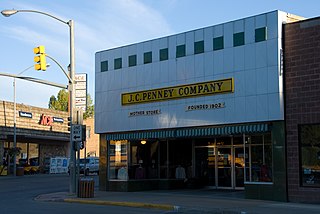
The J. C. Penney Historic District is a historic district in Kemmerer, Wyoming encompassing several properties associated with James Cash Penney (1875-1971). The district includes the Golden Rule Store, the first in what became the J. C. Penney department store chain, and Penney's home during the store's early years. The district was declared a National Historic Landmark District in 1978, for Penney's role in creating one of the first national department store chains.

The Woodrow Wilson Boyhood Home is a historic house museum at 419 7th Street in Augusta, Georgia. Built in 1859, it was a childhood home of Woodrow Wilson (1856–1924), the 28th president of the United States and proponent of the League of Nations. The house is owned and operated by Historic Augusta, Inc., and was designated a National Historic Landmark on October 6, 2008.

The Murray Downtown Residential Historic District is the best representative area of the residential settlement and development of the city of Murray, Utah, United States. It was listed on the National Register of Historic Places in 2005. It is locally significant as a physical reflection of its residential architecture and the historic development of the city from its agricultural beginnings through its industrial era and current status as a small suburban city. The buildings within the district represent the wide range of architectural styles and plans popular in the city and the state of Utah between 1870 and 1954 and retain a high degree of integrity.

The University of Utah Circle, also known as Presidents Circle, is located on the campus of the University of Utah in Salt Lake City, Utah, United States. It was listed on the National Register of Historic Places in 1978 as a historic district.
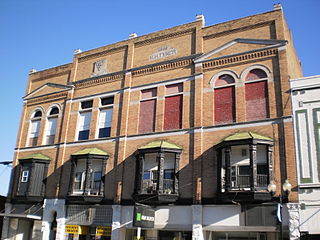
The Hartford City Courthouse Square Historic District is located in Hartford City, Indiana. Hartford City has a population of about 7,000 and is the county seat of Blackford County and the site of the county courthouse. The National Park Service of the United States Department of the Interior added the Hartford City Courthouse Square Historic District to the National Register of Historic Places on June 21, 2006 — meaning the buildings and objects that contribute to the continuity of the district are worthy of preservation because of their historical and architectural significance. The District has over 60 resources, including over 40 contributing buildings, over 10 non-contributing buildings, 1 contributing object, 8 non-contributing objects, and two other buildings that are listed separately in the National Register.
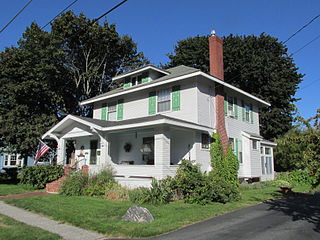
The Vallée Family House is an historic house at 36 Monroe Avenue in Westbrook, Maine. Built in 1914, this architecturally undistinguished American Foursquare house was a childhood home of entertainer Rudy Vallée during the period in which his interests in music and entertaining developed. It was listed on the National Register of Historic Places in 1993.

The Hines Mansion is a historic house in Provo, Utah, United States. It is listed on the National Register of Historic Places. It was built in 1895 for R. Spencer Hines and his wife Kitty. At the time the mansion was built, it was recognized as one of the finest homes in Provo. The Hines Mansion was designated to the Provo City Historic Landmarks Registry on March 7, 1996.
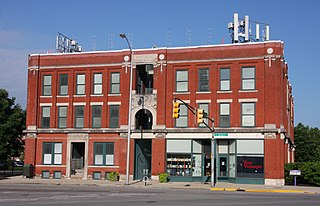
The Emelie was built in 1902 by German immigrant Frederick Schmid and named for his wife. The building was saved and restored by Browning Day Mullins Dierdorf Architects to serve as the company's corporate headquarters from 1987 to 2003. It is three stories, constructed of red brick and gray limestone. The building also includes a garden level. It is built in the German Renaissance Revival Architecture style. It has fine decorative detailing, totaling 35,000 square feet (3,300 m2). It has also served as an apartment building and commercial space.

The John H. Clark House is a historic residence in the village of Mechanicsburg, Ohio, United States. Built during Mechanicsburg's most prosperous period, it was the home of a prominent local doctor, and it has been named a historic site because of its historic architecture.

Front Royal Historic District is a national historic district located at Front Royal, Warren County, Virginia. The district encompasses approximately 470 contributing buildings and structures in the town of Front Royal. It has a mix of commercial, residential, industrial, religious and governmental buildings dating from the late-18th to mid-20th centuries. Notable buildings include the former Proctor-Biggs Mill, a former apple warehouse, Murphy's Theater (1908-1909), Compton's Corner, first Bank of Warren, Trout Drugstore Building, second Bank of Warren building (1914), Montview Hotel, Park Theater, the Henry Trout House, Mullen-Trout House, Giles-Cooke House, and the Dr. Manly Littleton Garrison. Located in the district and separately listed are the Balthis House and Warren County Courthouse.

The Todd Block is a historic commercial and civic building at 27-31 Main Street in Hinsdale, New Hampshire. It consists of two separate buildings that were conjoined in 1895, creating an architecturally diverse structure. The front portion of the building is a 2+1⁄2-story wood-frame structure with Second Empire styling; it is only one of two commercial buildings built in that style in the town, and the only one still standing. It was built in 1862, and originally housed shops on the ground floor and residential apartments above. The front of the block has a full two-story porch, with turned posts, decorative brackets and frieze moulding. The corners of the building are pilastered, and the mansard roof is pierced by numerous pedimented dormers. The rear section of the building was built in 1895 as a hall for the local chapter of the Independent Order of Odd Fellows (IOOF). The principal feature of this three-story structure is its east facade, which has a richly decorated two-story Queen Anne porch.

The Kucheman Building is a historic commercial building located in Bellevue, Iowa, United States. It is one of over 217 limestone structures in Jackson County from the mid-19th century, of which 20 are commercial buildings. The two-story structure was built in 1868 to house Kucheman & Son, a dry goods and clothing store. The second floor has housed an Opera Hall and City Hall. An addition was built onto the rear of the building sometime between 1902 and 1914. The building features four bays on its main facade, which is capped by a stone cornice with arched metal pediment. The stone blocks used in its construction vary somewhat in shape and size, and they were laid in courses. It also features dressed stone window sills and lintels. What differentiates this building from the others is its segmental arched windows. The second floor windows on the front have simple stone hoodmolds. The building was listed on the National Register of Historic Places in 1991.
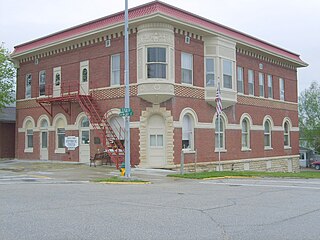
Maple View Sanitarium, also known as Community Hospital, Good Samaritan Nursing Home, and the Fayette County Historical Center, is a historic building located in West Union, Iowa, United States. It was built by Dr. Frank Beach Whitmore in 1903. The facility could accommodate 12 to 15 patients, it had its own operating room, and office. There was also a general store located in the commercial space on the main floor. Because medical care in a hospital was new in the community, it did not succeed and it folded in 1905. Whitmore left to become a missionary in China. The building housed professional offices and retail businesses until 1914 when the Nurses' Benevolent Association under the auspices of the Seventh-day Adventist Church bought the building for a hospital. It was more successful as a hospital the second time, and it was acquired by the city for a community hospital in 1920. After a new hospital building was constructed in 1951, the Good Samaritan Society bought the building for a nursing home. By 1973 changes in state law no longer made operating a nursing home here feasible. The Fayette County Historical Society acquired the building in 1975 for its use, and it operates a local history museum in the building. It was individually listed on the National Register of Historic Places in 1998. In 2015 it was included as a contributing property in the West Union Commercial Historic District.

The C.H. King Company and First National Bank Building, also known as Yellowstone Drug, is one of the oldest buildings in Shoshoni, Wyoming. The building was built for Charles Henry King in 1905–1906. King was a central Wyoming businessman who established a lumber business in the building. King is otherwise notable as the biological grandfather of U.S. president Gerald R. Ford. The First National Bank of Shoshoni was also located in the building.

The Rollin Sprague Building, also known as the Old Stone Store, is a commercial building located at 300 Main Street in Rochester, Michigan. It was listed on the National Register of Historic Places in 1999. The building is a rare example of coursed, cobblestone construction, and is the only known commercial building in Michigan featuring this type of construction.



















